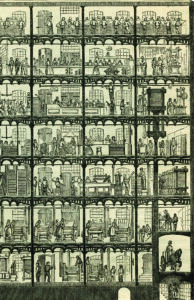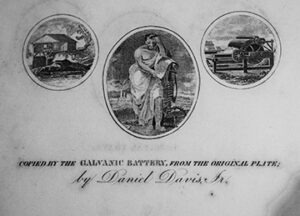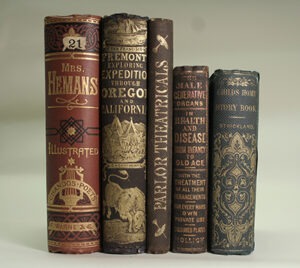Turning the Page: Technology & Innovation in 19th-Century Books
Date:
15 November 2012 – 1 March 2013
Location: Stettinius Gallery, Alderman Library
Curated by: Elizabeth Ott
 At the beginning of the nineteenth century, books were still manufactured using many of the same craft skills and techniques used since the introduction of moveable type in the fifteenth century. By the end of the 1800s, the book had changed from a largely handmade object to a mass-produced industrial product. This exhibition showcases the technological innovations that helped to transform book manufacture. Highlighted in each case are advances in papermaking, printing, binding, and illustration processes, all of which contributed to a century-long quest to make books more quickly, more cheaply, and in greater numbers than ever before.
At the beginning of the nineteenth century, books were still manufactured using many of the same craft skills and techniques used since the introduction of moveable type in the fifteenth century. By the end of the 1800s, the book had changed from a largely handmade object to a mass-produced industrial product. This exhibition showcases the technological innovations that helped to transform book manufacture. Highlighted in each case are advances in papermaking, printing, binding, and illustration processes, all of which contributed to a century-long quest to make books more quickly, more cheaply, and in greater numbers than ever before.

The caption under this image, printed from an electrotype plate copied from a copper original, shows the pride nineteenth-century printers took adopting the latest technology
The driving force behind innovation in book manufacture was an expanded readership. Literacy rates climbed throughout the century, ensuring an ever-increasing audience of readers from all walks of life. As the middle class expanded, new readers had both the money and leisure to purchase books in every genre, from literary fiction and poetry to science, technology, and political economy. The demand for more books, more variety, and more novelty inspired printers to experiment with every aspect of book production, hoping to find ever more economical ways to manufacture books.
Nineteenth-century book makers approached the printing of books as a technological puzzle. Their solutions to that puzzle radically changed what kinds of information could be contained on a printed page, how many people that information could reach, and how quickly that information could spread. Because of their innovative approaches to producing books, nineteenth-century bookmakers helped fuel a revolution in human communication.
Illustrating Books
Illustrated books, magazines, newspapers, and journals enjoyed robust popularity throughout the nineteenth century. In order to keep pace with the demand for illustrated books, artists and printers recovered and refined illustration techniques, and they developed new methods for producing prints. Highlighted in this exhibit are three processes characteristic of nineteenth-century illustration: wood engraving, steel engraving, and lithography. New processes and improved techniques allowed illustrations to be produced much faster and in far greater numbers.
Capturing the Printed Page
Printing and publishing books had always involved a gamble. The cast type used to print books was one of the most expensive investments for printers. Leaving type standing, that is composed and ready to print, was not always possible. But, if the book proved popular and the type had already been distributed, the book would have to be completely reset, costing time and money. Over the course of the nineteenth century, printers sought new ways of duplicating set type, so that popular books could be reprinted without resetting. Two of the most popular methods of duplicating set type were stereotyping and electrotyping. Both processes produced solid plates replicating a page of type.

The variety of decorative designs on the spines of these nineteenth-century books exemplifies the different genres these works represent and also a spirit of innovation in binding design
Clothing the Book
In the nineteenth century, publishers increasingly sought to package their books in covers that were distinctive, uniform, and produced in a cost-efficient manner. The adoption of cloth as a covering material, its use in conjunction with a case binding style, and the flourishing of methods for decorating book cloth all contributed to the advancement of nineteenth-century book production. Often bright and colorful, incorporating a wide variety of styles and designs, nineteenth-century books attracted a diverse readers by appealing directly to their clientele.
Making Paper
For much of the history of books, paper had been the limiting factor in book production. Paper was expensive to produce from linen and cotton rags, and had to be made one sheet at a time using a hand-held paper mold. Papermakers in the nineteenth century tackled these problems with two different innovations: papermaking machines and wood-pulp paper. Papermaking machines supplanted the paper mold as the primary technology for producing paper, allowing large, continuous rolls of paper to be produced in a process that was almost entirely automated. Paper could be made faster, and at larger sizes than ever before. The use of wood, straw, and other materials in paper pulp significantly reduced the cost of making paper.
Advancing the Book
In the twentieth century, technologies of book production continued to evolve, with advances in book production such as phototypesetting, xerography, and electronic texts. Twenty-first century books continue to push the boundaries of technology, and participate in the newest trends—from Twitter feeds that reprint the entire text of Moby Dick to best-selling novels composed through text messages—but the relationship between books and technology is not a new development, as this exhibition shows. To understand the history of books and the transmission of texts, scholars must look to the technologies of book production, and to the men and women who invented, owned, and operated those technologies. Whether printed one sheet at a time on an iron press or sped through a dizzying array of spinning cylinders, every book bears the impress of its maker, and attests to the human desire to spread knowledge, language, art, science, and ideas.
Elizabeth Ott is a Ph.D. candidate in the Department of English at the University of Virginia, where she is currently working on a dissertation focused on the role of the circulating library in nineteenth-century Britain. Elizabeth’s broader research interests include nineteenth-century poetry, the digital humanities, and the history of the book. Elizabeth joined the Rare Book School staff in January 2011 as Program Assistant.
This exhibition is made possible by Rare Book School and The Jefferson Trust, an initiative of the UVA Alumni Association, as part of the “Why Books Matter” Exhibition Series, celebrating Rare Book School’s twentieth anniversary on Grounds.
